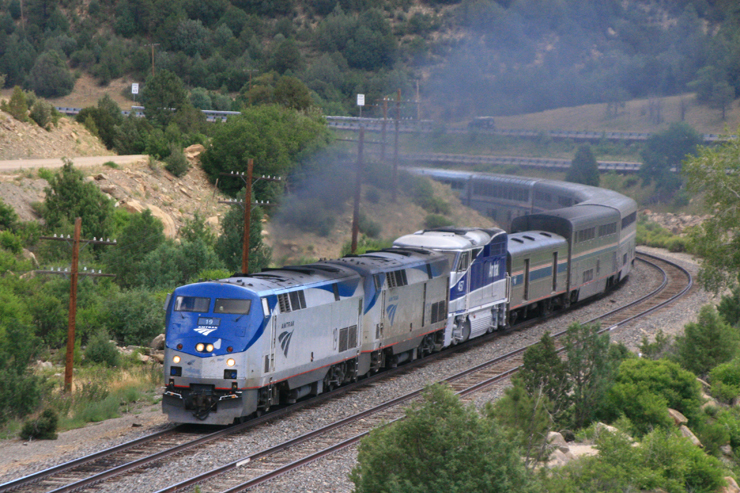
WASHINGTON — When outgoing CEO William Flynn joined the company in March 2020, a direction for Amtrak that de-emphasized long distance trains and national network investment had already been established under Amtrak Board Chairman Anthony Coscia.

Stephen Gardner, hired by then-President and CEO Joseph Boardman, has been the primary confidant on strategy for two other short-term CEOs, Wick Moorman and Richard Anderson, who were brought in to replace Boardman in 2017. Since then, Gardner has assumed more responsibility on both the commercial and operations sides, and has been the common thread in management as chief executive titles and responsibilities above him changed [see “Amtrak CEO Bill Flynn to retire,” Trains News Wire, Dec. 15, 2021].
But the term of Coscia and every other board member has expired, and reform provisions of the recently-passed Infrastructure Investment and Jobs Act take direct aim at reorienting Amtrak priorities away from their current trajectory. Among the changes:
— Board of Directors composition is to include two members each from states representing the Northeast Corridor, state-supported service, and long-distance trains. They would still nominated by the U.S. President and confirmed by the Senate, but must be actively engaged with passenger rail and communities it serves, not political appointees who have only a limited knowledge of Amtrak’s product and needs of the traveling public and disabled community.
— Maximizing the benefits to rural areas with federal investment across the entire network, rather than focusing on minimizing costs as a primary corporate goal. Current management argues Northeast Corridor trains (at least in pre-pandemic times) have been at least operationally self-sufficient. Meanwhile, allocations of company-wide and route costs to long-distance trains have justified cuts to capacity and amenities for those services.
— A requirement to revise cost-allocation methodology, in conjunction with the State-Amtrak Intercity Passenger Rail Committee, to be more transparent. The methology, which is also used to calculate long-distance train expenses, has been a constant complaint of state operating authorities.
In 2018, a bipartisan group of senators representing Kansas, Colorado, and New Mexico began to challenge Amtrak’s plan under Anderson to replace part the Southwest Chief with bus service rather than continue the Boardman-led effort to use locally sponsored federal grants to rehabilitate the route. The recent legislation’s directives have expanded calls for Amtrak to re-examine triweekly and discontinued routes, as well as onboard service in response to constituent complaints, in part because lawmakers continue to be unsatisfied with management’s current approach.
By installing Gardner now as CEO, the current board of directors can exert influence on future investment priorities just as Amtrak is poised to receive more money for infrastructure than it ever has before. Coscia is from New Jersey, where needs are significant.
Gardner’s knowledge can provide continuity regardless of who is nominated to the new board. The question is whether the new board will actively exert oversight on management to ensure it fulfills the intent of the legislation, which the current board has declined to do.
Nomination and confirmation of that new board shows no sign of moving swiftly as the Biden administration faces challenges, so Gardner is likely to have some time to show how he intends to comply with the spirit of the law’s prescriptive requirements.














My family and I have been planning a trip to New Orleans during April, 2021. I really wanted to make it a train trip from Boston, as I live in New Hampshire. (the other part of the family would leave from Philadelphia, but would go by air because they have school related time constraints for their school age children) I have the funds or Guest Reward points to easily afford the trip. I thought I had the the time, but actually I don’t. I have been checking the train status of The Crescent southbound since November 9th. It has not arrived on time even once. That’s 0/41 as the arrival for Dec 20, 2021. I reluctantly started checking the northbound performance ten days later. On time 11/32 trips. Now would you book this trip, in either direction with an on time record like that? I think Mr. Gardner has his work cut out for him to even make a dent in this situation. And somehow, I don’t think just throwing money at the problem is not going to help. (It hurts me to say that Southwest Airlines can make the in both half the time and for less than half the money.)
As Mr Shapp stated why not eliminate the NEC then too? Except for NY to Phld which is basically a commuter distance trip Amtrak carries the smallest % of trips along the NEC again the drive is the most common. There is a term the use to describe neighborhoods without sufficient food retailers called a “food desert” the same could be said of rural areas with little or no other transportation options as transportation deserts. So we eliminate their options but use their taxes to saturate a short corridor which already has an abundance of private enterprise choices. This market already has stiff competition which results in fares lower than they should be to compete, yet Amtrak puts the bulk of its funding into this corridor in which it is dead last!
How often does Amtrak really fit anybody’s travel needs outside the NEC?
Travel speeds are similar to cars. Ticket prices are higher than gasoline. Timing differs along the route, but my times would involve boarding and detraining between 21:00 and 08:00, depending on direction. Since it’s so “slow” the train can’t service every stop at a remotely convenient time. If you’re not at the endpoint (or 24 hours from it) timing won’t work. So, it fails on cost and convenience for all but a few people.
For long distances, flying is sadly more convenient and economical, but with a twist. The distance at which driving beats flying is increasing (hassle & rental car costs) but even there Amtrak can’t find a niche.
Self-driving cars are on the horizon, but the government keeps trying to change the laws of time and distance.
Mr. Evans, most trips in the NEC are made by car. So why not kill that too?
Patrick’s post is unfortunately true and we all know it. You could increase Amtrak’s national system by ten times it would be a niche service, possible for only a fraction of trips and most of those trips people wouldn’t take Amtrak.
For examples among my travels the last several years, I flew Milwaukee to Boston, I flew Milwaukee to Detroit, I flew Milwaukee to Denver, and I drove Milwaukee to Kankakee, though all those trips are possible on Amtrak. Most of the trips I’ve taken like, say, Nashville to Boston, or Milwaukee to Midland (Michigan) followed by Midland to Detroit, Amtrak wasn’t at all possible and even if it were the chances of me going by rail would have been infinitesimal.
Self-driving cars are on the horizon if that horizon is the 25th century… remember that Silicon Valley promised self driving cars ad drone delivery in 5 years about 10 years ago. Is a self-driving car that requires drivers to remain alert and ready to take over with the bare minimum of warning the hands-off snoring on the road robot car that have been touted by tech gurus, the media, and people who hate passenger trains? Super auto-pilot for highway driving and unmanned buses/taxis on fixed routes are doable, but there is increasing skepticism of “reliable” door-to-door automation.
Amtrak trains are not as fast as driving, most are far slower, even many corridor trains like the ‘Downeaster’ and if not for how slow traffic can be in Southern California, the ‘Pacific Surfliner’. Long distance trains averaging 55-mph are faster than corridor trains doing 45-mph or worse. The goal should be a ‘Brightline’ level of service — in terms of travel times, frequency, comfort, cost, and reliability — for state-supported Amtrak corridors. That will speed up a lot of long-distance trains too.
Flynn??? I thought Gardner had been running the whole thing since 2020. I figured it had been a real life version of Weekend at Bernie’s.
But why is Flynn retiring and on pretty short notice?
Board Chair, the NEC=Northeast Corridor=Nothing Else Counts champion Anthony Coscia surely knows. And he’s not going to tell and disgracefully there’s nobody in Amtrak Joey’s administration gonna make him.
Regarding “Nomination and confirmation of that new Board shows no sign of moving swiftly” that’s because those who really count don’t give a rat’s butt what happens to Amtrak. If that pathetic group of Senators who met with Flynn and Gardner in late October 2020 to get assurances of a return to daily service really cared, they would not have waited until AFTER the employee furloughs and tri-weekly service were implemented. That was like locking the barn door after the cows got out and disappeared over the hill. But those people and their enablers don’t ride. They don’t think it’s socially acceptable to ride except for a short trip for a photo op. They have never experienced the good, the bad, and the ugly of 18-20 hours on an LD and never will. Those who do ride are to the politicians the commoners, the ne’er do wells, the great unwashed, the hookers and the druggies and the drunks. So folks like Richard Anderson, William Flynn, Stephen Gardner and all the Flyboys Anderson brought aboard after he kicked out the institutional memory guys operated behind a smokescreen. No one calls them out because no one in a position to do that understands railroads. If they did, they might realise that the train delays are primarily caused by Amtrak’s own maintenance issues and the lack of mainline track capacity and operational flexibility out on the host railroads.
And hopefully he will last awhile! We have had a revolving door of one year plus CEO tenure since Boardman retired.
I don’t’ think Gardner is as corridor centric as you might be implying…remember he’s been around since Boardman and has always had a boss over his head, now he is going to be the boss with only the BoD to answer too. Give him a chance to settle in and see what he wants to do first before assuming it’s going to be same old, same old.
He knows his way around Amtrak and he knows where the bodies are buried —- and from what is known about him he seems capable. Good luck to him and let’s see where it leads. Things can’t get any worse…..
You are correct, Charles, on your last thought. But if that’s true, I think Stephen Gardner is, in large part, responsible for that state of affairs. But I want to ask, if the current Board’s terms “have expired”, how is Coscia&Co’s promotion of Gardner legit? At most, shouldn’t Gardner only be “Acting” CEO until a new Board convenes and decides who THEY want to run the company? Cosia’s move is a “Stop the Steal” I can gladly get behind.